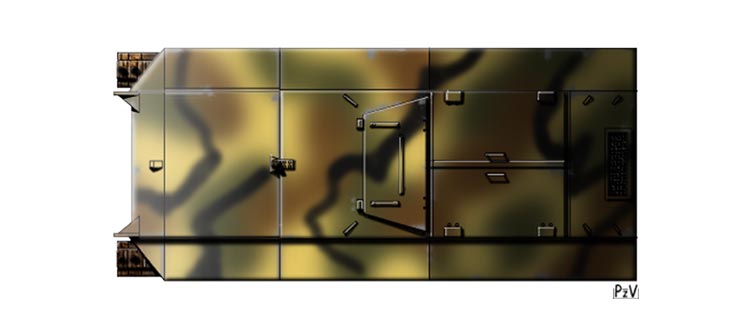NSU Springer Mittlere Ladunsträger Springer (SdKfz 304) Bovington
English Translation
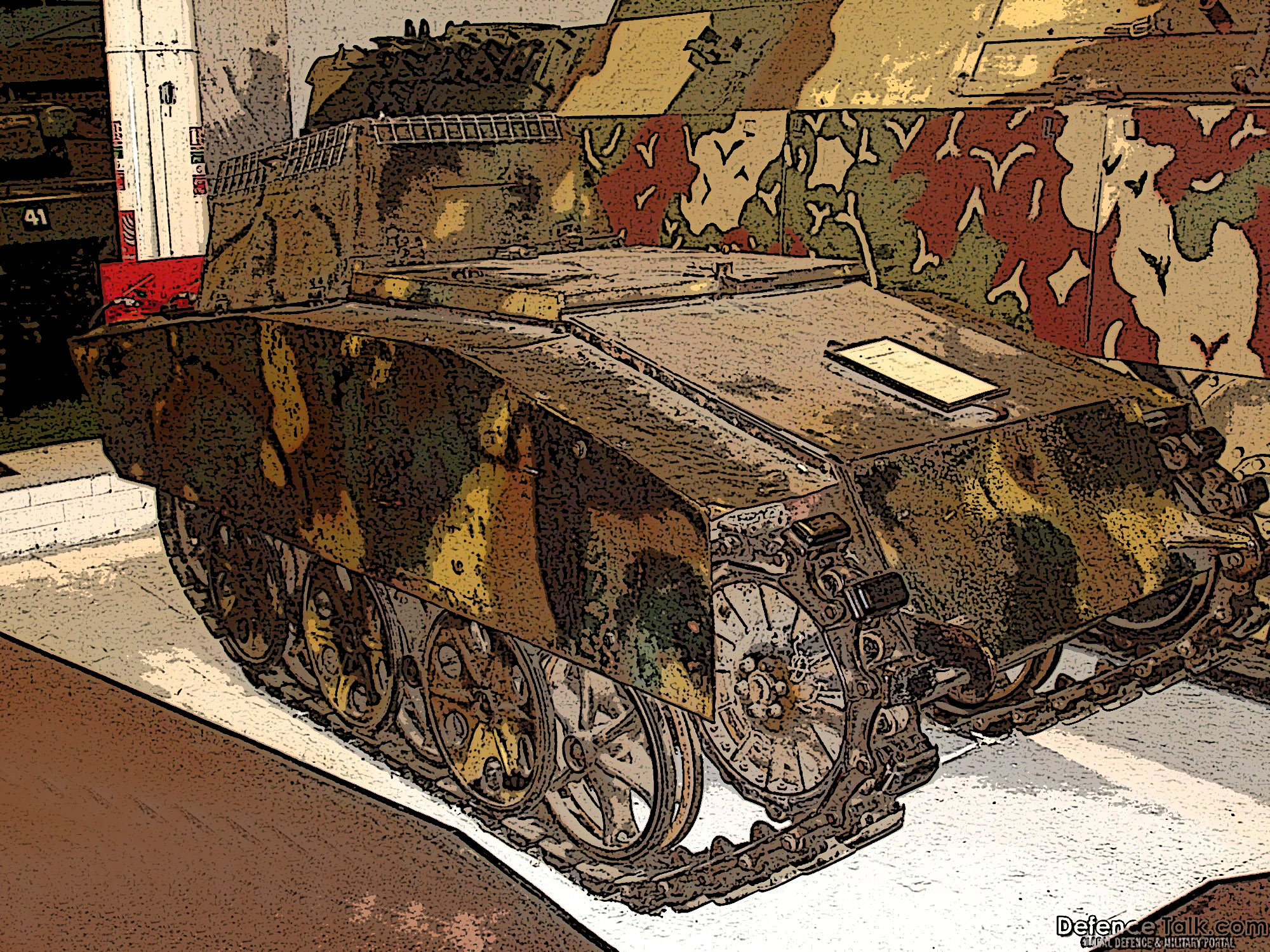 |
Le Springer ou SdKfz. 304 était un véhicule de démolition de l'armée allemande
Il faisait partie des télétank ou tank radio commandé
Teletank
Les Teletanks sont des chars sans pilote commandés à distance produits par certaines nations comme la France avec le Pommelet , l'Union soviétique et l'Allemagne dans les années 30 C’est les soviétiques ont trouvent également des avions et des bateaux radio guidés
Seul le teletanks allemand et soviétiques auront une utilisation réelle au combat
Un teletank est contrôlé par radio à partir d'un char de contrôle situé à une distance de 500 à1500 mètres, les deux constituant un telemechanical group ou groupement radio commandé Le char de contrôle fournit un appui-feu ainsi qu'une protection pour l'opérateur qui met en ouvre le char radio ou télé commandé Si l'ennemi a réussi à capturer le char RC ou teletank, l'équipage du char de contrôle est chargé de le détruire avec son armement principal en général le canon. Lorsqu'il n'est pas employé au combat le teletank est toujours mis en ouvre manuellement sans RC Chaque teletank, selon le modèle est en mesure de reconnaître de 16 à 24 commandes différentes envoyées via la radio sur deux fréquences possibles pour éviter les interférences et les brouillages.
Les Teletanks étaient équipés d’une charge militaire de 200/700kgs qui est deposée au plus près de l’ennemi afin de détruire des bunkers est des souterrains
Les Teletanks peuvent aussi emmener des Mitrailleuses des lance flammes des fumigènes ou des armes chimiques. Chez les soviétiques ils peuvent aussi être basés sur des châssis de chars communs comme les T 18 R 38 T 26 ou BT 7
les Teletanks soviétiques ont été utilisées durant la Guerre d'hiver et au début de la Grande guerre patriotique dans deux bataillons teletank
Les Teletanks Allemands (Remote Controlled Demolition Tank RCDV)
Les Allemands utilisent 3 types de RCDV (Remote Controlled Demolition Tank)
Goliath ( filoguidé )
Bogward B IV(Radio guidé)
NSU Springer (Radio Guidé)
mais ces engins ont été peu efficaces et ont souvent échoué dans leur mission, car ils pouvaient être arrêtés par des tirs d'armes légères . De plus ils coûtaient très cher et ils n'étaient pas très fiables.
Description
Leichte Ladunsträger Goliath (SdKfz 302 E et 303)
Cet appareil a été produit en 2 version
Moteur à essence V , (SdKfz 303) et moteur électrique E (SdKfz 302)
Les 2 modèles ont à peu près la même apparence extérieure. ils rassemblent au char anglais de la 1eGuerre Mondiale
Les tests réalisés avec le BI et BII Borgward Minenräuwagen (SdKfz 300) véhicules contrôlés à distance anti mine ont conduit à une commande à la fin de 1940 pour un petit véhicule qui serait équipé d'une charge explosive et qui pourrait être utilisé pour des applications plus larges que les opérations de déminage
Le prototype initial avait quatre grandes roues et des chenilles
Le Modèle de production a des roues plus petites ci qui permet d’avoir de la place pour la batterie il peut flotter et il possède assez d’espace pour l’emport d’une charge explosive de
En 1942, une nouvelle version du Goliath est commandée ce qui permet l’emport d’une charge plus lourde sur une plus grande distance
Zündapp developpe une version propulsée par un moteur de moto Zündapp 703 cc
Deux modèles du SdKfz 303 ont été construits
La version initiale portait une charge de démolition 75 kg et était plus petite et plus légère que le modèle final
650 m de fil se trouvent dans un tambour à l’arrière
La coque du Goliath est divisé en 3 compartiments
Le compartiment avant reçoit la charge explosive. Le moteur dans la version essence et les appareil de télécommande sont au centre et le câble dans le compartiment arrière
Dans la version électrique les piles électriques et les moteurs sont placés sur les cotés
Un couvercle en acier donne accès au compartiment ou se trouve le câble et télécommandes
le Goliath est entraîné par deux barbotins à l’avant. Il a un train de roulement à 4 bogies et un poulie tendeuse à l’arrière
Une petite roue jockey est montée entre le barbotin et le 1er bogie de chaque côté
En opération le Goliath est transporté vers la ligne de front par une remorque à 2 roues Il es t ensuite déchargé de la remorque et il est dirigé vers la cible contrôlé par un câble à 3 fils d’environ 600 mètres de longueur
Pour la version électrique chaque train de roulement est mis en action par un moteur alors que dans la version essence il y a un embrayage magnétique
Par contre le char ne possède pas de marche arrière
Dans la version à moteur essence (V) nous trouvons un capot d'admission d'air sur le haut de la coque, un pignon libre à rayons et 2 galets de retour
La charge est mise à feu par la batterie située dans l'unité de contrôle
Par contre l’ordre arrive via un interrupteur placé sur le panneau de contrôle par le câble à 3 fils
Le Goliath est consommable car il est entièrement détruit lors de l’explosion de sa charge de démolition
L'utilisation opérationnelle
La première unité à avoir utilisé le Goliath fut le Panzerpionner Kompanie (Goliath) 811 et 815 qui faisaient partie de la Heerespionnerbataillion (MOT) zbV 600 (Taifun)
Il était toujours en service avec le Pionnersturmbrigade 627
Il a été en action à Koursk avec la Panzerjägerabteilung Schwere 654e (sur Ferdinand) pour le déminage
Caractéristiques
E Motor
Production 2650 avril 1942 / Janvier 1944
Poids 370 kg
Longueur 1.5m
largeur 0.85m
Hauteur 0.56m
Moteur 2 Bosch MM / RQL électrique 2,5 kW
BAV 1 avant 1 arrière
Vitesse 10 km / h
Portée 1.5 km
Armement explosif 60 kgs HE Sprengladung
V Moteur
Production 4604 avril 1943 / Septembre 1944
Poids 430 kg
Longueur 1,6 m
Largeur 0.91m
Hauteur 0.62m
Moteur Zündapp SZ 7 2 cylindres 703 cc
BAV 2 'avant 1 marche arrière
Vitesse 12km / h
Portée 12 km
Armement Explosif 75 kgs HE Sprengladung SdKfz 303a
100 kg SE Sprengladung SdKfz 303b
Bogward B IV
Ce petit char RC de démolition est plus grand que le Goliath et il était tout aussi inefficace que le précédent
Le Ladunsträger B IV a été construit pour transporter une charge de démolition puissante vers un objectif précis la déposer et revenir Ce véhicule est inspiré des chars utilisés par les allemands lors de la campagne de France avec des chars PzKpfw. I Ausf. B modifiés équipés d'un appareil spécial afin de placer des charges explosives Ces chars étaient RC et pouvaient être réutilisés 10 PzKpfw. I Ausf. B modifiés ont été utilisés par la 1e. Panzer Division - Pioniereeinheits 3. Pionierekompanie
En Octobre 1941 Bogward reçoit une commande afin de développer un véhicule à usage spécial avec fonction RC Ce véhicule était basé sur les 301 VK Munitionsschlepper
Borgward bénéficie pour développer le B III VK 302 du l’expérience du schwere ladungstranger B IV SdKfz. 301 et des engins BI et B II leichter ladungstranger Goliath SdKfz. 302
La Coque fine est construite avec les plaques soudée de 5 mm et de 8 mm
Elle est divisée en divers compartiments avec le moteur à l'arrière. Le Compartiment conduite à l'avant droit et radio à l'avant gauche
L’engin est chenillé avec barbotin à l’avant et cinq galets et 2 roues tendeuses à l’arrière
Un moteur 6 cylindres essence est monté sur le côté avant gauche
2 réservoirs d'essence sont sur le côté droit et au centre nous trouvons le mécanisme hydraulique pour le fonctionnement RC
L'Ausf. B est légèrement différent du Ausf. A, car il pesait 400 kg de plus, les antennes de radio a été déplacée et l'équipement hertzien a été améliorée.
Le Borgward IV Ausf. C pèse 4.85tonnes mesure 4,1 m de longueur, 1,83 m de largeur et 1,25 m de hauteur. Il est construit avec un blindage plus épais et utilise de nouvelles chenilles.
Sur le Borgward Ausf C le poste de pilotage a été déplacé de la droite vers la gauche. Il a également utilisé un moteur Borgward ,plus puissant d’environ 78hp.
À la fin de la guerre 56 Borgward IV ont été reconditionnés en Panzerjaeger Wanze armé de six 8.8cm Raketenpanzerbüchse 54
Certains Borgward IV Ausf. B ont été également reconstruits et testés avec gouvernail, hélice afin de servir d’engins amphibies.
En 1943, un seul Borgward fut équipé d'une caméra de télévision dans le but de diriger un groupe de chars RC afin de visionner l’action.
Opération
Le B IV arrive sur la zone de combat par ses propres moyens et continue jusqu’à la proximité de la cible ensuite le conducteur quitte le char et en prend le contrôle par RC pour l’ orienter jusqu’à destination
Contrairement au Goliath le B IV n’est pas consommable car il dépose sa charge d'explosif sur la cible et revient (normalement)
La charge militaire de TNT est dans un conteneur placé sur l'avant du véhicule en pente
La charge est libérée, soit directement par RC ou par un mécanisme de déclenchement qui fonctionnent lorsque le véhicule a rejoint sa cible
Il va équiper les Panzerkompanien (Funklenk) 311 312 313 et 314 et les Panzer Abteilungen (Funklenk) 301 et 302
En Juillet 1943, le 312e Panzerkompanie subordonnées au groupe d'armées Centre Il utilise avec succès le BIV dans les champs de mines autour de Koursk
Caractéristiques
Numero de châssis 350001
Verduchsfährzeuge (prototype 12 avril 1942 )
Borgward Ausf A 616 (Mai 1942 / Juin 1943)
Borgward Ausf B 260 (Juillet 1943 Novembre 1943)
Borgward Ausf. C 305 (Décembre 1943 Septembre 1944)
Poids 3,6 tonnes
équipage 1
Longueur 3,65 m
Largeur 1.8m
Hauteur 1.19 m
Moteur Bogward 6M RTB 2,31 litre
BAV 2 Avant 1 arrière
Vitesse 38kms / h
Rayon d’action 212 Kms
Radio UKE6 EP3 mit
Armement 500kgs HE Sprengladung
NSU Springer
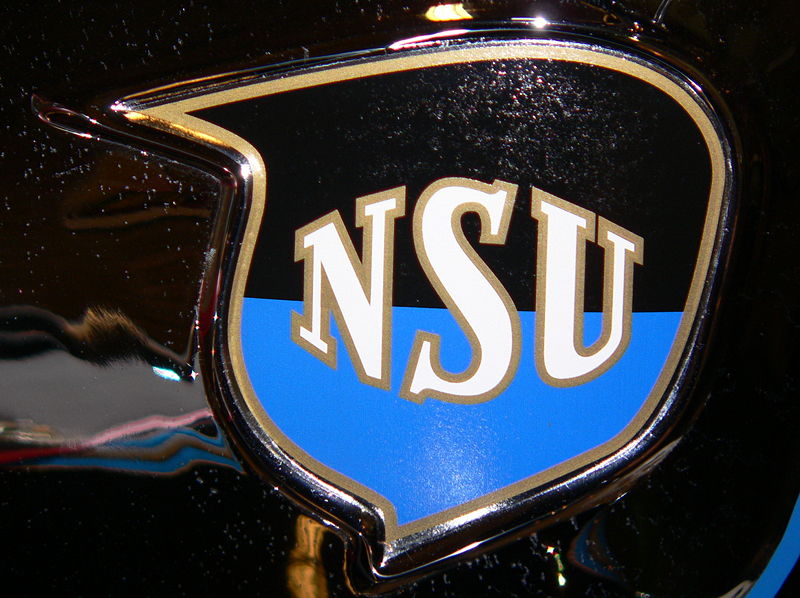 |
| |
Ce véhicule n’a jamais été utilisé au combat Il s'agit d'un TCDV de taille intermédiaire légèrement blindé mais il n’en n’est pas moins vulnérable aux attaques comme les Goliath et BIV
Pour remplacer les Goliath et B IV on décide de construire un engin plus efficace et moins coûteux avec une production prévue en 1944
Mais entre Octobre 1944 et Février 1945, seulement 50 ont été construits et ils n’ont pas été très utilisés
Une autre version est prévue pour le Springer le Wanze Kleinpanzer armés de canon sans recul IG 105mm
Description
Il a été construit par NSU (Werke AG de Neckarsulm) avec de nombreux composants du Kettenkrad (SdKfz 2) S
Sa mission délivrer sur la cible ennemie 320 Kg d’explosifs
C’est un véhicule avec un seul homme d’équipage blindé assis à l'arrière . Il doit amener son Springer aussi près de l'ennemi que possible.
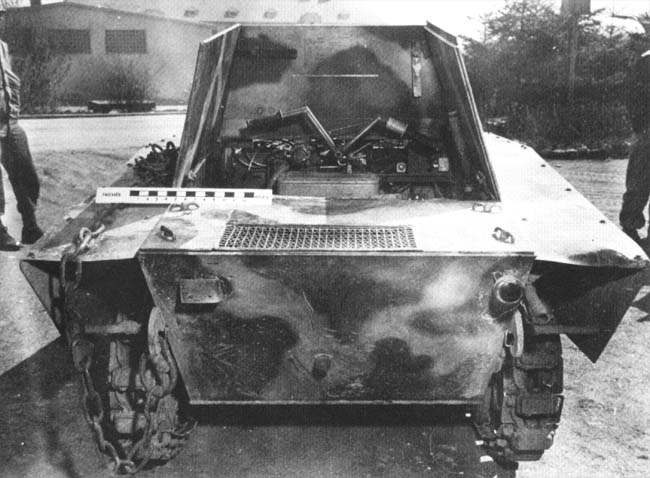 |
| Springer ( Vue arriere) Internet |
Ensuite le pilote quitter l’engin et dirige le Springer par RC vers l'ennemi et le fait exploser. Pour sa production on utilisé des composants existants comme le. train de roulement le moteur de l'Opel Olympia, une partie des organes de roulement
Il avait trois externes et trois roues intérieures en marche. Le train de roulement avec 4 galets permet de rendre le véhicule capable de transporter une charge utile plus importante
L’approche finale et la mise à feu de la charge est contrôlée par Fil ou sans fil grâce à un dispositif de commande à distance.
le Springer aurait du équiper des Compagnie de StuG 40 auf G qui devaient les diriger vers leurs cibles. Chaque Zug avait un StuG 40 de commandement et 3 StuG 40 contrôlant chacun trois Springer
.jpg) |
.jpg) |
| Merci à Vincent |
Merci à Vincent |
Caractéristiques
Poids 2,4 tonnes
Equipage 1
Longueur 3,17 m
Largeur 1.43m
Hauteur 1.45 m
Moteur 1.5 litres Pôle Olympia
Vitesse 42 km/h
Rayon d action 200 kms
Radio Ke 6 avec UKE6
Armement 300 kgs HE (Sprengstoff)
Attention le Grillage sur le Springer est une protection posée par le Musée
Autre Photoscope (Other Walk Around ) 1
Springer Mittlere Ladunsträger Springer (Sdkfz 304) Bovington
 |
Springer or SdKfz. 304 was a demolition vehicle of the German army
He was a télétank part of a Serie of wireless remotely controlled Tank
Teletank
Teletanks were remotely controlled unmanned Tank produced by some nations among who France with the Pommelet Soviet Union and Germany in the 30s Soviet have also telecutters and teleplanes
Only the German and soviets teletanks were use in combat
A teletank is controlled by radio from a control tank at a distance of 500–1,500 meters, the two constituting a telemechanical group. The control tank would provide fire support as well as protection for the radio control operator. If the enemy was successful at seizing the teletank, the control tank crew was instructed to destroy it with the main gun. When not in combat the teletank was driven manually. Each teletank, depending on model was able to recognize sixteen to twenty-four different commands sent via radio on two possible frequencies to avoid interference and jamming.
Teletanks were equipped with 200–700 kgs time bomb in an armored box, dropped by the tank near the enemy's fortifications and used to destroy bunkers up to four levels below ground
Teletanks have also MG Flamethrowers smoke canisters and they are capable to transport chemical weapons . They were based on regular tanks chassis as T 18 R 38 T 26 or BT 7
In soviet Army Teletanks were used during the Winter War and at the beginning of the Great Patriotic War with two teletank battalions
The German Remote Controlled Demolition Tank
German use 3 types of RCDV ( Remote Controlled Demolition Tank)
Goliath ( Line controlled)
Bogward B IV Radio Controlled
NSU Springer
But this devices have failed some time in the mission because they could be stopped by small arms fire and they are were expensive and they were not very reliable.
Description
Goliath leichte Ladunsträger( SdKfz 302 E motor and 303 V motor)
This device was produced in 2 models Gasoline (SdKfz 303) and electric engine( SdKfz 302)
The 2 models have roughly the same external appearance . they reassemble at a littleWW1 tank
Test carried out with the Borgward B I et BII Minenräuwagen ( SdKfz 300 ) remote controlled minefield clearance vehicle led to an order to the end of 1940 for a small vehicle which would carry an explosive charge and which could be used for wider applications than minefield clearance
The initial prototype had four large wheels and trackwork. Production model however has smaller wheels which allowed room for battery carrying sponson,s on either side and left more space for explosive charge Guidance was by 3 strand wire two for steering and one for detonating the charge
In 1942 a new version of the goliath was ordered which would allow an heavier charge to be carried over greater distance
Zündapp therefore developed a version powered by a zundapp 703 cc motorcycle engine
Two models of the Sd Kfz 303 were built
The initial version carried a 75 kgs demolition charge and was smaller and lighter than the final model
650 m of wire guidance was carried on the drum
The Hull of the goliath is divided into 3 compartments
The front compartment receive the explosive charge . The engine in gasoline version and control gear are in the center and the cable is on the rear compartment
for electrical versions batteries and motor are carried on sponsors on both sides
Hanged steel covers give access to cable compartment and engine space
Goliath is driven by front sprockets . They are 3 bogie wheels maintained on lever arms with simple coil spring and a rear idler
A small jockey wheel is mounted between the driving sprocket and the 1st bogie wheeel on each side
In operation Goliath is transported to front line by 2 wheeled trailer After et has been unloaded from the trailer and started toward target it is controlled through a 3 core cable about 600 meters length
I electrical version the control is direct to motor which drive each track individually In gasoline version the control operate magnetic clutches with control upon tracks
There are not rear march
In Version V motor a air intake cowl is on the Hull top , spoked idler and 2 return rollers (this Charge is fired by the battery located in the control unit Firing is initiated by throwing a switch on the control panel The firing circuit run through the outer wires in the 3 core cable
The goliath is expendable and destroyed when its demolition charge is set off
Operational use
The first unit to be used with the Goliath were Panzerpionner Kompanen (Goliath ) 811 and 815 which were part of the Heerespionnerbataillion (mot) zbV 600 (Taifun)
Also in service with the Pionnersturmbrigade 627
She was see in action at Kursk near the 654th Schwere Panzerjägerabteilung ( with Ferdinand) for minefield clearance
Technical Data
E Motor
Production 2650 form April 1942 /January 1944
Weight 370 kg
Length 1.5m
width 0.85m
Height 0.56m
Engine 2 Bosch MM/RQL electric 2.5kw
Gearbox 1 forward 1 reverse
Speed 10 kms/h
Range 1.5 km
Armament 60 kgs HE Sprengladung
V Motor
Production 4604 form April 1943 /September 1944
Weight 430 kg
Length 1.6 m
Width 0.91m
Height 0.62m
Engine Zündapp SZ 7 2 cylinders 703 cc
Gearbox 2 forward 1 reverse
Speed 12kms/h
Range 12 km
Armament 75 kgs HE Sprengladung SdKfz 303a
100 kgs HE Sprengladung SdKfz 303b
Bogward B IV
This radio Controlled Demolition Tank is larger then the Goliath and he was also a unsuccessful device
The Ladunsträger B IV was designate to carry a heavy demolition charge to a specific target where the charge was dropped . Vehicle back down and the charge detonate First use of this system by German took place during Campaign of France by modificated Pz I PzKpfw. I Ausf. B fitted with special equipment to place explosive charges instead of sacrificing the entire vehicle. 10 modified PzKpfw. I Ausf. B were used by 1. Panzer Division - Pioniereeinheits 3. Pionierekompanie
In October 1941 Bogward were ordered to develop a special purpose vehicle with radio control feature . This vehicle was based upon the Munitionsschlepper VK 301
, Borgward to develop the B III VK 302 to a schwere ladungsträger - B IV SdKfz. 301 and from the experiences with the B I and B II a leichter ladungsträger Goliath SdKfz. 302.
Hull is built with think welded of 5 mm and after 8 mm armour plate and it is divided into engine compartment at the rear . Drive compartment on the right front and radio equipment on the left front
The device is fully tracked with front driving sprocket five bogies wheels and a rear idles on each side
A 6 cylinder gasoline engine is fitted on the left front side
2 gasoline tanks are on the right side and in the center we found the hydraulic mechanism for operation under radio control
The Ausf. B only differed a little from Ausf. A, it weighed 400kg more, the radio antennae was moved and the radio-equipment had been improved. Borgward IV Ausf. C weighed 4.85tons, measured 4.1m in length, 1.83m in width and 1.25m in height. It carried thicker armor and used new tracks.
and on the Borgward ausf C drivers position were moved from right to the left side. It also used a more powerful Borgward engine, providing some 78hp.
At the end of war 56 Borgward IV were rebuilt to panzerjäger Wanze armed with six 8.8cm Raketenpanzerbüchse 54
Some Borgward IV Ausf. B were also rebuilt and tested with rudder, propeller and floating bulbs for swimming purposes.
In 1943 single Borgward IV was fitted with a TV-camera with the purpose to sit in the control-tank and watch a simple TV-screen to see how one drove.
Operation
B IV is driving under its own power until line departure near target usually Pill Boxes or bunker
Control transmitter of radio equipment retained by driver when he dismount is used to steer
the vehicle to its destination
in contrast with the Goliath B IV is not expendable because he depose its load of explosive at the target and return ( normally)
TNT charge is in a container placed on the sloping front of the vehicle / The charge is released either directly by radio control or by trip mechanism which operate when vehicle has joint the target
Issued to Panzerkompanien (Funklenk) 311 312 313 and 314 and panzer abteilungen (Funklenk) 301 and 302
In July 1943 the 312th Panzerkompanie subordinated to Army Group Centre use successfully the BIV in minefields clearance at Kursk
Technical data
Chassis number 350001
Verduchsfährzeuge 12 (April 1942)
Borgward Ausf A 616 ( May 1942 /June 1943)
Borgward Ausf B 260 (July 1943 November 1943)
Borgward Ausf. C 305(December 1943 September 1944 )
Weight 3.6 tons
Crew1
Length 3.65m
Width 1.8m
Height 1.19 m
Engine Bogward 6M RTB 2.31 liter
Gearbox 2 Forward 1 reverse
Speed 38kms/h
Range 212 Kms
Radio EP3 mit UKE6
Armament 500kgs HE Sprengladung
NSU Springer
This vehicle was never see in action It is a TCDV of intermediate size lightly armoured . Ha was no less vulnerable to attack then goliath and BIV
To replace Goliath and B IV he was ordered a more effective and cheaper device for a production scheduled in 1944 but from October of 1944 to February of 1945 only 50 were built and they saw very little service
Another version was planned for the Springer the Kleinpanzer Wanze armed with recoilless 105mm IG gun
Description
 |
| |
He was built by NSU (Werke AG de Neckarsulm) with many components of the Kettenkrad (SdKfz 2)His mission blow up the enemy. with 320 Kg of HE
He was a single man armoured vehicle which his driven (driver, was sit in the back of the Springer ) as close to the enemy as possible . After driver leave the device and direct the Springer by remote control towards the enemy and detonated. It was produced) like the . drive-train, engine from the Opel Olympia, parts of the running gear He had three outer and three inner running wheels. This running gear has two pairs of road wheels were to make the vehicle capable of carrying a bigger payload.
Final approach and the detonation of the charge was controlled by a wire- or wireless remote control device.
Springer was issued to normal radio controlled armoured companies which had a Stug 40 auf G to direct them to the target area .Each zug had a command Stug 40 and 3 stug 40 each controlling three Springer
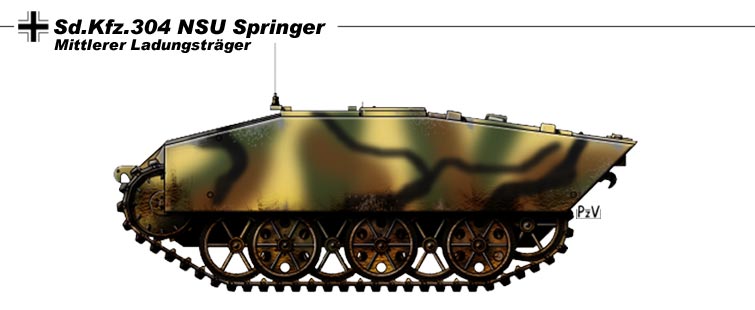 |
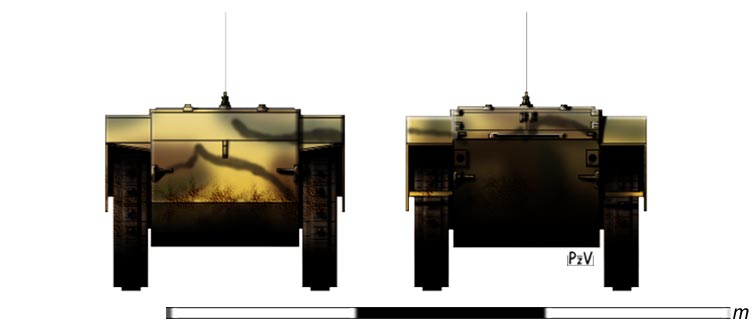 |
| Thank to Vincent |
Thank to Vincent |
Technical data
Weight 2.4 tons
Crew 1
Length 3.17 m
Width 1.43m
Height 1.45 m
Engine Pole Olympia 1.5 liter
Speed 42 km/h
Range 200 kms
Radio Ke 6 mit UKE6
Armament 300 kgs HE ( Sprengstoff)
Be carefull the wire netting put upon the springer is a museum protection
















.jpg)
.jpg)
.jpg)


